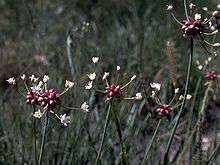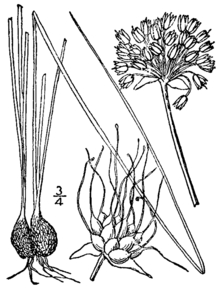Allium canadense
| Canada onion | |
|---|---|
 | |
 | |
| 1913 drawing[1] | |
| Scientific classification | |
| Kingdom: | Plantae |
| Clade: | Angiosperms |
| Clade: | Monocots |
| Order: | Asparagales |
| Family: | Amaryllidaceae |
| Subfamily: | Allioideae |
| Tribe: | Allieae |
| Genus: | Allium |
| Species: | A. canadense |
| Binomial name | |
| Allium canadense L. | |
| Synonyms[2][3] | |
| |
Allium canadense, also known as Canada onion, Canadian garlic, wild garlic, meadow garlic and wild onion [4] is a perennial plant native to eastern North America from Texas to Florida to New Brunswick to Montana. The species is also cultivated in other regions as an ornamental and as a garden culinary herb.[5] The plant is also reportedly naturalized in Cuba.[6]
Description
Allium canadense has an edible bulb covered with a dense skin of brown fibers and tastes like an onion. The plant also has strong, onion-like, odor. Crow garlic (Allium vineale) is similar, but it has a strong garlic taste.[7]
The narrow, grass-like leaves originate near the base of the stem, which is topped by a dome-like cluster of star-shaped, pink or white flowers. These flowers may be partially or entirely replaced by bulblets.[7] When present, the flowers are hermaphroditic (both male and female organs) and are pollinated by American bees (not honeybees) and other insects. It typically flowers in the spring and early summer, from May to June.[7][8][9][10][11][12][13][14]
Varieties
The bulblet-producing form is classified as A. canadense var. canadense.[7] It was once thought that the tree onion could be related to this plant,[15] but it is now known that the cultivated tree onion is a hybrid between the common onion (A. cepa) and Welsh onion (A. fistulosum), classified as A. × proliferum.[16]
Five varieties of the species are widely recognized:[3][7]
- Allium canadense var. canadense - most pedicels replaced by bulbils rarely producing fruits or seeds, most of the range of the species
- Allium canadense var. ecristatum Ownbey tepals deep pink and rather thick, coastal plain of Texas
- Allium canadense var. fraseri Ownbey - flowers white, Great Plains from Texas to Kansas
- Allium canadense var. hyacinthoides (Bush) Ownbey - tepals pink, thin, flowers fragrant, northern Texas and southern Oklahoma
- Allium canadense var. lavandulare (Bates) Ownbey & Aase - flowers lavender, not fragrant, northern Arkansas to South Dakota
- Allium canadense var. mobilense (Regel) Ownbey - flowers lilac, pedicels thread-like, southeastern US
Uses
The Canada onion is cultivated as a vegetable in home gardens in Cuba, scattered locally in the south to western parts of the island. It was formerly collected from the wild to be eaten by Native Americans and by European settlers.[17] Various Native American tribes also used the plant for other purposes: for example, rubbing the plant on the body for protection from insect, lizard, scorpion, and tarantula bites.[18]
This plant can cause gastroenteritis in young children who ingest parts of this plant. Chronic ingestion of the bulbs reduces iodine uptake by the thyroid gland, which can lead to problems. No specific treatment is suggested other than to prevent dehydration (Lampe and McCann 1985). Livestock have also been poisoned by ingesting wild onions, and some have died (Pipal 1918). Horses have developed hemolytic anemia from ingesting wild onion leaves (Scoggan 1989).[19]
References
- ↑ illustration from Britton, N.L., and A. Brown. 1913. Illustrated flora of the northern states and Canada. Vol. 1: 499.
- ↑ "Tropicos - Name - !Allium canadense L.". tropicos.org.
- 1 2 "Allium canadense L. — The Plant List". theplantlist.org.
- ↑ Germplasm Resources Information Network - (GRIN). "Allium canadense information from NPGS/GRIN". USDA, ARS, National Genetic Resources Program. Retrieved 21 February 2011.
- ↑ Izel, Native Plants For Your Garden, Washington DC, Allium canadense
- ↑ "World Checklist of Selected Plant Families: Royal Botanic Gardens, Kew". kew.org.
- 1 2 3 4 5 "Allium canadense in Flora of North America @ efloras.org". Flora of North America, Vol. 26. Retrieved 21 February 2011.
- ↑ "vol. 2 - Caroli Linnaei ... Species plantarum - Biodiversity Heritage Library". biodiversitylibrary.org. p. 1195.
- ↑ Correll, D. S. & M. C. Johnston. 1970. Manual of the Vascular Plants of Texas i–xv, 1–1881. The University of Texas at Dallas, Richardson.
- ↑ Great Plains Flora Association. 1986. Flora of the Great Plains i–vii, 1–1392. University Press of Kansas, Lawrence
- ↑ Schwegman, J. E. 1991. The Vascular Flora of Langham Island, Kankakee County, Illinois. Erigenia 11: 1–8.
- ↑ Voss, E. G. 1972. Gymnosperms and Monocots. i–xv, 1–488. In Michigan Flora. Cranbrook Institute of Science, Bloomfield Hills, Michigan.
- ↑ Wunderlin, R. P. 1998. Guide to the Vascular Plants of Florida i–x, 1–806. University Press of Florida, Gainesville.
- ↑ Gleason, H. A. & A.J. Cronquist. 1968. The Pteridophytoa, Gymnospermae and Monocotyledoneae. 1: 1–482. In H. A. Gleason New Britton and Brown Illustrated Flora of the Northeastern United States and Adjacent Canada (ed. 3). New York Botanical Garden, New York.
- ↑ Food Resource, Oregon State University. "ALLIUM CANADENSE, TREE ONION, WILD ONION". originally from Hedrick, U.P. ed., Sturtevant's Notes on Edible Plants (1919). Retrieved 21 February 2011.
- ↑ Germplasm Resources Information Network - (GRIN). "Allium x proliferum information from NPGS/GRIN". USDA, ARS, National Genetic Resources Program. Retrieved 21 February 2011.
- ↑ Hanelt, Peter (2001). "Alliaceae". In P. Hanelt. Mansfeld's Encyclopedia of Agricultural and Horticultural Crops (except ornamentals). Berlin: Spring-Verlag. p. 2250. ISBN 3-540-41017-1.
- ↑ Moerman, David E. (1998). Native American Ethnobotany. Portland, OR: Timber Press. p. 57. ISBN 0-88192-453-9.
- ↑ Munro, Derek B. Canadian Poisonous Plants Information System : wild onion. Government of Canada. Retrieved 28 May 2011.
Further reading
- Wild Onion: Allium Canadense
- Missouri Plants: Allium canadense
- Plants For A Future: Allium canadense
- http://lactarius.com/courses/spring_flora/allcan.htm
- http://www.sbs.utexas.edu/bio406d/images/pics/all/allium_canadense.htm
.jpg)